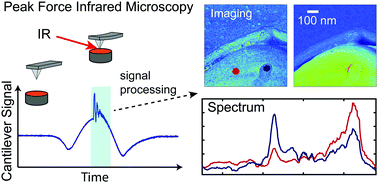Principle and applications of peak force infrared microscopy†
Abstract
Peak force infrared (PFIR) microscopy is an emerging atomic force microscopy (AFM)-based infrared microscopy that bypasses Abbe's diffraction limit on spatial resolution. The PFIR microscopy utilizes a nanoscopically sharp AFM tip to mechanically detect the tip-enhanced infrared photothermal response of the sample in the time domain. The time-gated mechanical signals of cantilever deflections transduce the infrared absorption of the sample, delivering infrared imaging and spectroscopy capability at sub 10 nm spatial resolution. Both the infrared absorption response and mechanical properties of the sample are obtained in parallel while preserving the surface integrity of the sample. This review describes the constructions of the PFIR microscope and several variations, including multiple-pulse excitation, total internal reflection geometry, dual-color configuration, liquid-phase operations, and integrations with simultaneous surface potential measurement. Representative applications of PFIR microscopy are also included in this review. In the outlook section, we lay out several future directions of innovations in PFIR microscopy and applications in chemical and material research.

- This article is part of the themed collection: Nanoscale Spectroscopy


 Please wait while we load your content...
Please wait while we load your content...